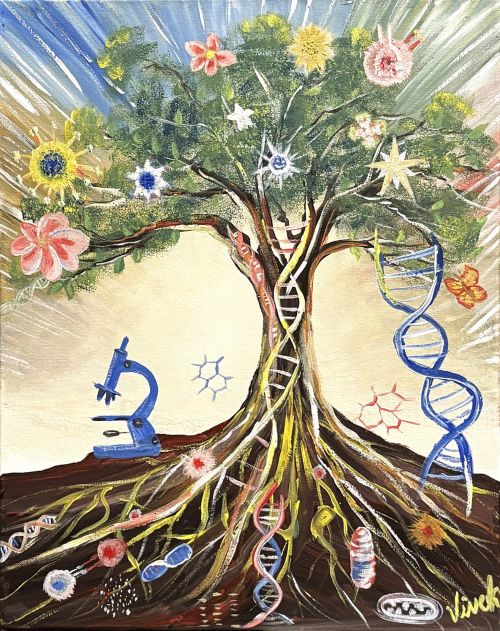St. Jude Family of Websites
Explore our cutting edge research, world-class patient care, career opportunities and more.
St. Jude Children's Research Hospital Home

- Fundraising
St. Jude Family of Websites
Explore our cutting edge research, world-class patient care, career opportunities and more.
St. Jude Children's Research Hospital Home

- Fundraising
Get to know the artist
The Strategic Communication, Education and Outreach (SCEO) Department recently hosted the Art of Science Competition, calling upon St. Jude employees to submit original artistic renderings of scientific concepts. Vivek Choudhary was chosen as the grand prize winner for his acrylic painting on canvas entitled Science: The Hope and Healing.
Five questions with Vivek Choudhary, DVM, PhD, MPH

1. What is your background and how long have you been creating science art?
I hold a Doctor of Veterinary Medicine (DVM) degree, a PhD in Animal Genetics, and a Master of Public Health (MPH). Following my doctoral studies, I pursued postdoctoral training, gaining extensive experience in cancer research, inflammatory dermatological conditions, corneal wound healing, etc. Additionally, I have worked as a Research Scientist, further refining my expertise in above-mentioned areas, contributing to both academic and translational research.
I have been interested in various forms of art since childhood, but I began painting in 2013 after being inspired by a colleague. While I have explored different artistic styles over the years, this is my first time creating science-themed art specifically for this competition. I always strive to bring an artistic touch to everything I do, but my primary focus is on painting. While I originally wanted to use oil paints [on this piece], I chose to work with acrylics due to their safer and less hazardous nature.
2. Have you entered other competitions like this one?
This is the first time I have entered an art competition. As a hobby painter, I felt inspired to take part in this competition, which motivated me to create this painting. This competition has been a wonderful opportunity to reconnect with my passion for painting, and I look forward to continuing to explore the intersection of science and art.
Beyond my own artistic journey, I am also encouraging my children to develop an interest in painting. I hope that one day they will create beautiful artworks of their own and find the same joy in artistic expression that I do.

About the art on the Research home page:
This artwork illustrates the vital connection between scientific research and the healing of young lives. The tree's roots, embedded with symbols of science—DNA strands, cells, and microscopes- represent the foundational research driving breakthroughs in pediatric medicine. The branches nurture and support vibrant leaves and glowing flowers, symbolizing the resilience and recovery of children. Together, they convey the powerful role of science as a source of both hope and healing.
3. Do you think a competition like this–and giving a platform to showcase this unique skillset–is important for scientists?
I believe that everyone has talents beyond their professional work, and many scientists possess artistic abilities that often go unrecognized. However, with the demands of research, they may not always have the time or opportunity to explore their creative side. Having a creative outlet is essential for maintaining balance, and for me, painting serves as a refreshing break that helps me recharge. This competition provided the motivation I needed to pick up my brush again for the first time since moving to the Memphis area.
Competitions like this are incredibly important because they offer scientists a platform to showcase their artistic skills and encourage creative expression. They foster a sense of belonging, appreciation, and personal fulfillment.
4. Describe the impact that you think art has in STEM fields.
I believe that art and science go hand in hand, and art has a significant impact on STEM fields. Incorporating art into the learning process enhances creativity, improves problem-solving skills, and makes complex scientific concepts more accessible and engaging.
Visual representation, design thinking, and creative storytelling help communicate scientific ideas more effectively, whether through data visualization, medical illustrations, or innovative engineering designs.
My own children attend schools where art is integrated into their education, and I have seen firsthand how this approach fosters a deeper understanding and enthusiasm for STEM subjects. By blending art with science, we can encourage innovation, enrich learning experiences, and inspire the next generation of scientists and engineers.
5. Do you have any plans for any other science art projects?
I truly enjoyed creating this piece for the competition, and it has reignited my passion for painting. This experience has inspired me to explore more opportunities to create science-themed artwork. I look forward to experimenting with new ideas that blend scientific concepts with artistic expression in the future.